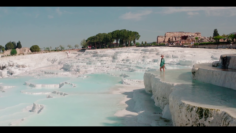İshak Paşa Palace
İshak Paşa Palace is one of Türkiye’s lesser-known but significant treasures. It is located approximately 7 km. southeast of Ağrı city center and overlooks the plain of Doğubayazıt. The palace is also called İshak Paşa Castle, Ottoman Castle and İshak Paşa Complex.
Construction of the palace was commenced in 1685 by Çolak Abdi Paşa, one of the Çıldır Atabeks, and was completed in 1784 during the time of Küçük İshak Paşa, a descendant of the same lineage.
The palace bears the characteristics of Ottoman palace architecture as well as recognized as the second-largest palace built in Ottoman art after Topkapı Palace. Some researchers suggest that the palace contains 360 rooms. It also bears similarities in terms of spatial layout with Edirne Palace and Topkapı Palace.
İshak Paşa Palace is known as one of the first buildings to use a central heating system. The gaps within the stone walls provide evidence that the palace was heated with a system resembling modern central heating.
The mosque, minaret, narthex, and mausoleum are the most well-preserved structures of the palace today.
The location of the palace was chosen specifically for defense and to maintain control over the city. The fact that İshak Paşa Palace is the only surviving structure from the old city of Doğubayazıt further supports this purpose.
The first courtyard is entered through a magnificent grand gate, which serves as the main entrance to the palace and is asymmetrically positioned slightly south of the eastern facade, composed of high and thick walls. This grand gate, adorned with reliefs, decorations, and rich floral motifs, showcases the craftsmanship of Seljuk art and its artists.
Due to its layout, İshak Paşa Palace, built in accordance with the Ottoman palace organization, deserves to be mentioned alongside Topkapı Palace and Edirne Palace.
For these reasons, the palace possesses a rare value in terms of history and art history, one that is seldom encountered elsewhere.















